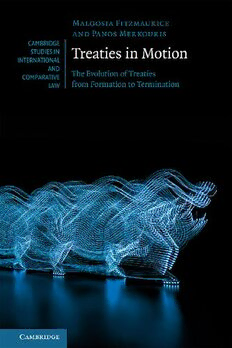
Treaties in Motion: The Evolution of Treaties from Formation to Termination PDF
Preview Treaties in Motion: The Evolution of Treaties from Formation to Termination
TREATIES IN MOTION Thelawoftreatiesisinconstantmotion,understoodnotonlyaslocomo- tion, but also as motion through time and as change. Thus, kinesis and stasis,twosidesofthesameconceptof‘motion’,arethecentralthemesof TreatiesinMotion. Theconceptofmotionadoptedinthisbookisbasedonthephilosophy ofAristotle.Heidentifiedsixtypesofmotion:creation(genesis),increase (auxesis),diminution(meiosis),alteration(alloiosis),destruction(phthora), andchangeofplace(katatoponmetabole),whichhasbeenamendedbythe authors to change in space-time (kata topon kai chronon metavole) to reflectourmodernscientificunderstandingoftimeasadimensionthrough whichmotionandchangeoccurs. Each chapter’s analysis proceeds by focusing on a specific area of a treaty’s ‘life-cycle’, where each type of motion shines through and is describedthroughthreedifferentframesofreference: treaties,theVienna ConventionoftheLawofTreaties,andcustomarylaw. is Professor of International Law at the School of Law, Queen Mary University of London and an associate memberoftheInstitutdeDroitInternational.Shehasdeliveredlectures at The Hague Academy of International Law, was involved in a multi stakeholder project funded by the EU Commission on environmental crime,isEditorinChiefofInternationalCommunityLawReviewjournal (ICLR)andQueenMaryStudiesinInternationalLaw,andhasadvisedas expertonlawoftreaties. isProfessorattheUniversityofGroningen.In2017 hewasawardedtheprestigiousERCStartingGrantforhis5-yearproject TRICI-Law (The Rules of Interpretation of Customary International Law).Hehaswrittenextensivelyonlawoftreatiesandoninterpretation, has been cited in international reports and cases, and has advised as expertontheseissues. CAMBRIDGE STUDIES IN INTERNATIONAL AND COMPARATIVE LAW: 149 Established in 1946, this series produces high quality, reflective and innovativescholarshipinthefieldofpublicinternationallaw.Itpublishes works on international law that are of a theoretical, historical, cross- disciplinaryordoctrinalnature.Theseriesalsowelcomesbooksproviding insights from private international law, comparative law and trans- national studies which inform international legal thought and practice moregenerally. The series seeks to publish views from diverse legal traditions and perspectives, and of any geographical origin. In this respect it invites studies offering regional perspectives on core problématiques of inter- national law, and in the same vein, it appreciates contrasts and debates between diverging approaches. Accordingly, books offering new or less orthodox perspectives are very much welcome. Works of a generalist character are greatly valued and the series is also open to studies on specificareas,institutionsorproblems.Translationsofthemostoutstand- ingworkspublishedinotherlanguagesarealsoconsidered. Afterseventyyears,CambridgeStudiesinInternationalandCompara- tive Law sets the standard for international legal scholarship and will continuetodefinethedisciplineasitevolvesintheyearstocome. SeriesEditors LarissavandenHerik ProfessorofPublicInternationalLaw,GrotiusCentre forInternationalLegalStudies,LeidenUniversity Jeand’Aspremont ProfessorofInternationalLaw,UniversityofManchester andSciencesPoLawSchool Alistofbooksintheseriescanbefoundattheendofthisvolume. TREATIES IN MOTION The Evolution of Treaties from Formation to Termination MALGOSIA FITZMAURICE QueenMaryUniversityofLondon PANOS MERKOURIS UniversityofGroningen UniversityPrintingHouse,CambridgeCB28BS,UnitedKingdom OneLibertyPlaza,20thFloor,NewYork,NY10006,USA 477WilliamstownRoad,PortMelbourne,VIC3207,Australia 314–321,3rdFloor,Plot3,SplendorForum,JasolaDistrictCentre,NewDelhi–110025,India 79AnsonRoad,#06–04/06,Singapore079906 CambridgeUniversityPressispartoftheUniversityofCambridge. ItfurtherstheUniversity’smissionbydisseminatingknowledgeinthepursuitof education,learning,andresearchatthehighestinternationallevelsofexcellence. www.cambridge.org Informationonthistitle:www.cambridge.org/9781108495882 DOI:10.1017/9781108863407 ©MalgosiaFitzmauriceandPanosMerkouris2020 Thispublicationisincopyright.Subjecttostatutoryexception andtotheprovisionsofrelevantcollectivelicensingagreements, noreproductionofanypartmaytakeplacewithoutthewritten permissionofCambridgeUniversityPress. Firstpublished2020 AcataloguerecordforthispublicationisavailablefromtheBritishLibrary. LibraryofCongressCataloging-in-PublicationData Names:Fitzmaurice,Malgosia,1957–author.|Merkouris,Panos,author. Title:Treatiesinmotion:theevolutionoftreatiesfromformationtotermination/Malgosia Fitzmaurice,QueenMary,UniversityofLondon;PanosMerkouris,UniversityofGroningen Description:Cambridge,UnitedKingdom;NewYork,NY,USA:Cambridge UniversityPress,2020.|Series:Cambridgestudiesininternationalandcomparativelaw| Includesbibliographicalreferencesandindex. Identifiers:LCCN2019057481(print)|LCCN2019057482(ebook)|ISBN9781108495882 (hardback)|ISBN9781108797924(paperback)|ISBN9781108863407(epub) Subjects:LCSH:Treaties. Classification:LCCKZ1301.F582020(print)|LCCKZ1301(ebook)|DDC341.3/7–dc23 LCrecordavailableathttps://lccn.loc.gov/2019057481 LCebookrecordavailableathttps://lccn.loc.gov/2019057482 ISBN978-1-108-49588-2Hardback CambridgeUniversityPresshasnoresponsibilityforthepersistenceoraccuracy ofURLsforexternalorthird-partyinternetwebsitesreferredtointhispublication anddoesnotguaranteethatanycontentonsuchwebsitesis,orwillremain, accurateorappropriate. CONTENTS List of Figures x List of Tables xi Acknowledgements xii List of Abbreviations xiii Table of Cases xix Table of Treaties xxxiii 1 Motion as a Notion 1 1.1 Introduction 1 1.2 TheForceThatSetThingsinMotion 2 1.3 NotionofMotion 3 1.4 MotionasChange 7 1.5 MotionthroughTime 9 1.6 MotionDependentonFramesofReference 13 1.7 MotioninTreatiesinMotion 14 2 Treaty Genesis: Concept of a Treaty in International Law, Including Its Formation and Motion 23 2.1 Introduction 23 2.2 DefinitionofaTreatyinthe1969VCLT 28 2.2.1 Introduction 28 2.2.2 ‘LegalObligation’and‘GovernedbyInternationalLaw’ 29 2.2.3 FormandSubstanceoftheTreatyinTheirInfinite Variety 32 2.2.3.1 PreliminaryRemarks 32 2.2.3.2 FormandSubstanceofaTreatybeforeInternational CourtsandTribunals 35 2.2.4 RegistrationoftheTreaty(Article102oftheUN Charter) 56 2.2.5 Conclusions 57 2.3 MemorandaofUnderstanding 59 2.4 UnilateralActsofStates 63 2.4.1 Introduction 63 v vi 2.4.2 UnilateralActs:TheirContentandFormandtheLawof Treaties 64 2.5 SoftLaw 68 2.5.1 States’ObligationsandClimateChangeTreaties 82 2.5.2 Conclusions 87 2.6 ReflectionsontheRoleofGoodFaith 92 2.7 Conclusions 93 3 Consent to Be Bound: The Force behind the Motion of Treaties 96 3.1 Introduction 96 3.2 ClassicalMethodsoftheConsenttoBeBoundandtheVCLT 98 3.3 ModificationofStates’ConsentthroughReservationsto Treaties 101 3.3.1 IntroductoryObservations 101 3.3.2 RegimeoftheViennaConvention:GapsandConfusion 104 3.4 EvolutionofConsenttoBeBoundintheEnvironmentalLaw Context 111 3.5 TheorisingConsentinInternationalLaw 113 3.6 ConsenttoBeBoundandClassificationofTreaties 116 3.7 Conclusions 120 4 Treaty Interpretation and Its Rules: Of Motion through Time, ‘Time-Will’, and ‘Time-Bubbles’ 121 4.1 Introduction 121 4.2 ContemporaneousInterpretationvEvolutiveInterpretation:Content StasisvContentMotion 123 4.2.1 InterpretativeMotionthroughTime:IntertemporalityandIts ConnectiontoInterpretation 123 4.2.2 PrincipleofContemporaneityandEvolutiveInterpretation: StasisorKinesis? 128 4.2.2.1 ContemporaneousvEvolutiveInterpretation 128 4.2.2.2 EvolutiveInterpretationandSubsequentAgreements andPractice 133 4.2.2.3 ChoosingbetweenStatic(Contemporaneous)and EvolutiveInterpretation 135 4.2.2.4 LimitsofEvolutiveInterpretation 141 4.3 MotionthroughTimeoftheRulesonInterpretation 147 4.3.1 ClaimThatRulesofInterpretation,DespitethePassage ofTime,AreImmutable 158 4.3.1.1 VeryExistenceofRulesofInterpretation 158 4.3.1.2 VariousFormsofRulesofInterpretation 162 4.3.1.3 InterpretationofRulesofInterpretation 168 vii 4.3.1.4 LogicalFallaciesoftheImmutabilityofRulesof Interpretation 172 4.3.2 MutabilityofRulesofInterpretationLeadstoIntertemporal Concerns 174 4.3.2.1 EffectofTimeonRulesofInterpretation 174 4.3.2.2 Scenarios(Dis)Allowing‘Time-Travelling’Rulesof Interpretation 175 4.4 ForwardandBackwardMotionthroughTime:Rulesof Interpretationas‘Time-Travellers’ 179 5 Amendment/Modification/Revision of Treaties: Motion as Change 182 5.1 Introduction 182 5.2 DraftingHistoryofArticle39-41VCLT 183 5.2.1 CharacteristicsandDefinitionsofRulesRelating toA/M/R 183 5.2.1.1 NeedforA/M/RArticlesintheVCLT 183 5.2.1.2 DefinitionalIssuesofA/M/R 187 5.2.2 CriticalIssuesRelatingtotheProcessofA/M/Rin theVCLT 188 5.2.2.1 RightsandObligationsofStatesduringA/M/R Procedures 189 5.2.2.2 UnanimityRule 190 5.3 TrendsandIssuesinA/M/RofTreaties 192 5.3.1 Introduction 192 5.3.2 TacitAcceptanceProcedure 193 5.3.2.1 TacitAcceptanceProcedureinInternational Treaties 194 5.3.2.2 LegalityandTelosoftheTacitAcceptance Procedure 196 5.3.2.3 Raisond’ÊtreoftheTacitAcceptanceProcedure: TheIMOExample 197 5.3.2.4 CharacterisationoftheTacitAcceptance Procedure 201 5.3.3 COPs/MOPsinMEAsandAmendment/Modification Thereof 202 5.3.3.1 LegalCharacterisationofCOPs/MOPs 202 5.3.4 LegitimacyofA/M/RbyCOPs 211 5.3.5 JuxtapositionofA/M/RwithInterpretation 215 5.3.5.1 InterconnectivityofA/M/RwithOtherAspectsof the‘Life-Cycle’ofTreaties 215 5.3.5.2 A/M/RandInterpretation 216 5.3.5.3 TheDifferencebetweenA/M/Rand Interpretation 221 5.3.6 SubsequentCustomaryLawandTreatyModification 231 viii 5.4 EmpiricalAnalysisofA/M/RProvisionsinMultilateral Treaties 232 5.4.1 DataonA/M/RProvisions 232 5.4.2 A/M/RProvisionsinMultilateralTreaties 236 5.4.3 AdoptionandEntryintoForceofProposedA/M/Rsof MultilateralTreaties 241 5.4.3.1 Adoption 244 5.4.3.2 EntryintoForce 252 5.4.4 AmendmentofAmendmentProcedures 263 5.5 Conclusions 268 6 Treaties and Their Phthora: Withdrawing from and Terminating/Suspending Treaties 270 6.1 Introduction 270 6.2 WithdrawingfromaTreatywithoutaWithdrawalProvision 272 6.2.1 NegativeorPositivePresumption 273 6.2.2 TheNatureoftheTreaty 275 6.3 WritingontheWall(andItsSubsequentErasing):Withdrawaland WithdrawingtheWithdrawal 278 6.3.1 UKandEU:A‘Half-HeartedRelationship’ 279 6.3.2 WithdrawalMechanism 281 6.3.3 WightmanPetitioninUKCourts 283 6.3.4 WithdrawaloftheNotificationofWithdrawal 285 6.4 AnomalousTermination/SuspensionofaTreaty 293 6.4.1 Praeter-VCLTGroundsforTreatyTermination/Suspensionor Non-Performance 295 6.4.1.1 Desuetude 295 6.4.1.2 ExceptioInadimpletiContractus 301 6.4.2 Intra-VCLTGroundsforTreatyTermination/ Suspension 307 6.4.2.1 SuperveningImpossibilityofPerformance 307 6.4.2.2 FundamentalChangeofCircumstances 309 6.4.2.3 MaterialBreach 313 6.5 Relative‘Motion’ofGroundsforTreatyTermination 319 6.5.1 Relative‘Motion’ofPraeter-VCLTGroundstoIntra-VCLT Grounds 320 6.5.1.1 DesuetudeandFundamentalChangeof Circumstances 320 6.5.1.2 ExceptioInadimpletiContractusandMaterial Breach 321 6.5.2 Relative‘Motion’ofIntra-andPraeter-VCLTGroundstoState Responsibility 325 6.5.2.1 SuperveningImpossibilityofPerformanceandState Responsibility 326 ix 6.5.2.2 MaterialBreach(andExceptio)andState Responsibility 328 6.6 Conclusions 333 7 Concluding Remarks 334 Bibliography 340 Index 372
